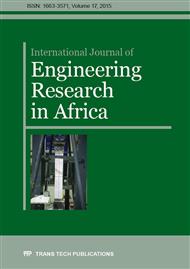[1]
J. van der Geer, J.A.J. Hanraads, R.A. Lupton, The art of writing a scientific article, J. Sci. Commun. 163 (2000) 51-59.
Google Scholar
[2]
M. Jasty et al, The initiation of failure in cemented femoral components of hip arthroplasties, J Bone Joint Surg (1991) 551–558.
DOI: 10.1302/0301-620x.73b4.2071634
Google Scholar
[3]
N. Nuño, G. Avanzolini, Residual stresses at the stem–cement interface of an idealized cemented hip stem, Journal of Biomechanics (2002) 849–852.
DOI: 10.1016/s0021-9290(02)00026-x
Google Scholar
[4]
A.M. Ahmed, R. Nair, D. L Burke, J. Miller, Transient and residual stresses and displacements in self-curing bone cement – Part 2: Thermoelastic analysis of the stem fixation system. ASME, J. Biomech Eng (1982) 28–37.
DOI: 10.1115/1.3138300
Google Scholar
[5]
A.M. Ahmed, D.L. Burke, J. Miller, R. Nair, Transient and residual stresses and displacements in self-curing bone cement—Part 1: Characterization of relevant volumetric behavior of bone cement, Journal of Biomechanical Engineering (1982) 21–27.
DOI: 10.1115/1.3138299
Google Scholar
[6]
A. Roques, M. Brown, A. Taylor, A. New, D. Baker, Quantitative measurement of the stresses induced during polymerisation of bone cement, Biomaterials (2004) 4415–4424.
DOI: 10.1016/j.biomaterials.2003.11.009
Google Scholar
[7]
A.M. Ahmed, D.L. Burke, J. Miller, R. Nair, Transient and residual stresses and displacements in self-curing bone cement—Part 2: Thermoelastic analysis of the stem fixation system, Journal of Biomechanical Engineering (1982) 28–37.
DOI: 10.1115/1.3138300
Google Scholar
[8]
A.B. Lennon, P.J. Prendergast, Residual stress due to curing can initiate damage in porous bone cement: experimental and theoretical evidence, Journal of Biomechanics (2002) 311–321.
DOI: 10.1016/s0021-9290(01)00216-0
Google Scholar
[9]
C. Li, Y. Wang, J. Mason, The effects of curing history on residual stresses in bone cement during hip arthroplasty Journal of Biomedical Materials Research Part B: Applied Biomaterials (2004) 30–36.
DOI: 10.1002/jbm.b.30016
Google Scholar
[10]
J.F. Orr, N.J. Dunne, J.C. Quinn, Shrinkage stresses in bone cement, Biomaterials (2003) 2933–2940.
DOI: 10.1016/s0142-9612(03)00055-3
Google Scholar
[11]
P. Osorovitz, D. Goutallier, Résultats cliniques et radiographiques d'une série continue de 124 prothèses totales de hanche type Céraver-Ostéal. Revue de Chirurgie Orthopédique (1994) 305–315.
DOI: 10.1016/j.rcot.2013.03.027
Google Scholar
[12]
Bouziane. M. M, Benbarek. S, Tabeti. S.M. H, Bachir Bouiadjra. B, Serier. B, Achour. T, Finite element analysis of the mechanical behaviour of the different cemented hip femoral prostheses. Key Engineering Materials (2014) Vols (577-578) 349-352.
DOI: 10.4028/www.scientific.net/kem.577-578.349
Google Scholar
[13]
Gravius. S et al, In vitro interface and cement mantle analysis of different femur stem designs, " Journal of Biomechanics (2008) 2021–(2028).
DOI: 10.1016/j.jbiomech.2008.03.041
Google Scholar
[14]
G. Bergmann, HIP98, Free University, BerLin: ISBN 3-9807848-0-0 (2001).
Google Scholar
[15]
B. Bernd-Arno, N. Ingo, W. Prick, S. Christina; B. Anas, Numerical investigations on the strain adaptive bone remodelling in the periprosthetic femur: Influence of the boundary conditions, Biome Eng (2009).
Google Scholar
[16]
M.A. Perèz, J. Grasa, J.M. Garcıa Aznar, J.A. Bea, M. Doblare, Probabilistic analysis of the influence of the bonding degree of the stem–cement interface in the performance of cemented hip prostheses, Journal of Biomechanics (2006) 1859-1872.
DOI: 10.1016/j.jbiomech.2005.05.025
Google Scholar
[17]
J. Stolk, D. Janssen, R. Huiskes, N. Verdonschot,. Finite element-based preclinical testing of cemented total hip implants. Clin Orthop Relat Res (2007) 138-147.
DOI: 10.1097/blo.0b013e31802ba491
Google Scholar
[18]
D. Merckx, Les ciments orthopédiques dans la conception des prothèses articulaires. Biomécanique et biomatériaux, Cahiers d'enseignement de la SOFCOT, Expansion scientifique française (1993) 67-76.
Google Scholar
[19]
R. Huiskes, R. Boeklagen, Mathematical shape optimization of hip-prosthesis design J. Biomech (1989) 22 793.
DOI: 10.1016/0021-9290(89)90063-8
Google Scholar
[20]
A.B. Lennon, B.A.O. McCormack, The relationship between cement fatigue damage and implant surface finish in proximal femoral prostheses. Medical Engineering and Physics 25 (2003) 833–841.
DOI: 10.1016/s1350-4533(03)00120-6
Google Scholar
[21]
S. Toksvig-Larsen, H. Franzén, L. Ryd, Cement interface temperature in hip arthroplasty. Acta Orthopaedica Scandinavica 62 (2) (1991) 102–105.
DOI: 10.3109/17453679108999232
Google Scholar
[22]
C. Li, J. Mason, D. Yakimicki, Thermal characterization of PMMA-based bone cement curing, J. Mater. Sci. Mater. Med. 15 (2004) 85–89.
DOI: 10.1023/b:jmsm.0000010101.45352.d1
Google Scholar
[23]
N. Nuño, A. Madrala, D. Plamondon, Measurement of transient and residual stresses during polymerization of bone cement for cemented hip implants, J. Biomech. 41 (2008) 2605–2611.
DOI: 10.1016/j.jbiomech.2008.06.030
Google Scholar
[24]
D.M. Estok, W.H. Harris, A stem design change to reduce peak cement strains at the tip of cemented total hip arthroplasty, J. Arthroplasty (2000) 584-589.
DOI: 10.1054/arth.2000.6626
Google Scholar
[25]
D. Bennett, T. Goswami, Finite element analysis of hip stem designs, Materials and Design (2008) 45-60.
DOI: 10.1016/j.matdes.2006.12.014
Google Scholar
[26]
M.A. Perèz, J.M. Garcıa Aznar, M. Doblare, Analysis of the debonding of the stem–cement interface in intramedullary fixation using a non-linear fracture mechanics approach. Eng Fract Mech (2005) 1125–1147.
DOI: 10.1016/j.engfracmech.2004.09.002
Google Scholar
[27]
T.A. Gruen, G.M. McNeice, H.C. Amstutz, Clinical Orthopaedics and Related Research 141 (1979) 17–27.
Google Scholar
[28]
R.C. Gardiner, W.J. Hozack, Journal of Bone and Joint Surgery. British Volume 76 (1994) 49–52.
Google Scholar


